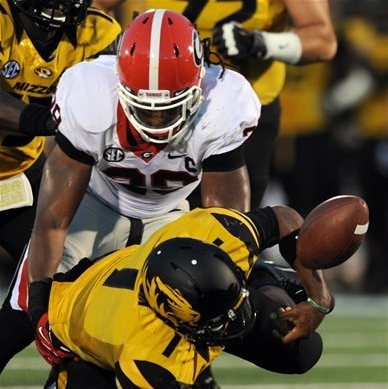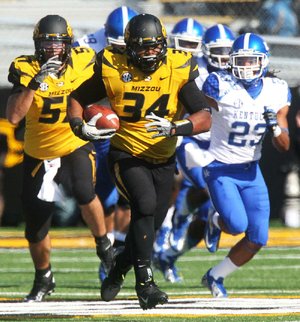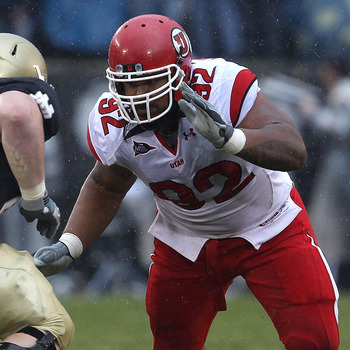DeAndre Hopkins dominated LSU's secondary, something not many people achieve
DeAndre Hopkins is Mr. Consistent – a clutch receiver without the eye-popping physical qualities. He makes up for it by getting the basics right – he catches with his hands, doesn’t have many drops, runs good routes and makes crucial rather than explosive plays.
Cordarrelle Patterson is the X-Factor player of the 2013 draft. He’s 6-3/6-4, could run a 4.35 at the combine and hits home runs. He’s a threat to score every time he gets the football, setting a school record for all purpose yards in his first season with Tennessee. Patterson doesn’t play with great technique, but he’s a playmaker.
Which is the better fit for the Seahawks?
On the one hand they have a young quarterback who needs as many consistent targets as possible. When it’s third down in a big game, Russell Wilson needs to know there are guys on the field he can rely on. He also needs as much dynamism as possible in this offense. Seattle likes to make quick strikes down field, usually off play action. Speed, height and reach are crucial as Wilson looks to exploit single coverage and jump-ball situations.
Hopkins is no slouch and we’re not talking about a mediocre athlete who can only run short, inside routes. You don’t get to 1405 yards and 18 touchdowns playing steady football. He can get downfield, he can run after the catch. Yet he doesn’t compare favourably with the statistical top-five receivers in the NFL who all weigh +225lbs and stand at least 6-3 tall. He compares favourably to Roddy White, but there aren’t many dominating receivers who play outside at his size.
Patterson had 1,858 all-purpose yards in 2012 – more than any other player in the SEC. He scored five receiving touchdowns and three rushing – plus two extra scores via punt and kick returns. However, he also faced something of a learning curve in his first season in the NCAA. His technique looks off and he looks every bit a player fresh out of the JUCO ranks. He gets his body into awkward positions to catch the ball and doesn’t often extend his hands to make a completion. These things can be coached and he has the athletic prowess to make for a worthy project.
Let’s look at the tape…
DeAndre Hopkins vs LSU
This was one of the all-time best performances I’ve seen from a receiver, mainly due to the sheer quantity of clutch plays. Sammy Watkins left the game in Clemson’s first offensive series through injury, meaning the LSU secondary could zone in on Hopkins. He still found ways to get open despite double coverage. He still made difficult passes with a corner draped all over him. He had two difficult touchdown receptions, several third down completions and made the play of the game on 4th and 16 to extend the game-winning drive.
Look at the technique at 0:35 in the video where he extends his arms to make a catch for the first down. Hopkins locates the ball mid-route, reaches out and plucks the football out of the air. Textbook reception.
At 1:49 he absorbs a holding call against the corner, fights off some physical coverage and still locates the back-shoulder throw for a completion. He needs to prove he can be physical at 6-1 and 200lbs.
The two touchdowns at 2:25 and 5:57 emphasise how crisp he runs his routes, how he can make difficult catches in traffic and convert on key downs. Bear in mind LSU were fully aware Tajh Boyd would be looking for Hopkins on both plays.
At 3:07 he flashes his athleticism to make a man miss and turn a short gain into a first down. The 4th and 16 conversion comes at 6:48 and prevents LSU from winning the game. Again – another tough grab.
The one thing that keeps jumping out – you don’t need to make a perfect throw with this guy. He’s going to adjust to the ball in the air, extend and complete the catch. He might not be the most dynamic receiver in college football. He might not run the fastest forty yard dash. But he’s a driven and ambitious player who will work hard to have an impact.
We talked about his character and drive to succeed in a piece earlier this week. I have no doubts that he’ll work hard at his craft. His personality and attitude appears to compare favourably to Julio Jones, who won major brownie points with the Atlanta Falcons because they knew they could trust him to work at his craft.
There are some issues too – as always. Hopkins is a pure hands catcher but he doesn’t necessarily have the strongest hands. Sometimes when a ball is a little high and he has to extend, he misses the catch. As cornerbacks in the NFL get bigger, questions are going to be asked if a player of this stature can win a high percentage of jump passes (a heavy staple in Seattle’s offense). Teams are looking for big receivers who don’t necessarily run a 4.3, but can be competitive and win 1vs1 match-ups in the air.
Neither is Hopkins a truly explosive player. While you can never truly have enough reliable pass-catchers, do the Seahawks need to look for something they don’t have? Is this an offense that lacks more of an X-Factor type – someone with unique dynamism who can make quick strikes downfield or major YAC? Or can we sometimes be distracted by flashy playmakers when really the core quality a receiver needs is the ability to get open and make a play. The question becomes, can Hopkins continue to get open and make regular plays in the bigger, faster world of the NFL?
One example that says he can is the game above. LSU’s secondary remains one of the best in college football. And he dominated them to the tune of 13 catches for 191 yards and two vital touchdowns. GM’s, scouts and coaches around the league will turn to this game when they sit down to scout Hopkins… and they’ll like what they see.
Cordarrelle Patterson vs Florida, Missouri, Vanderbilt and Georgia
Only the Florida game in the tape above was among Patterson’s most productive (eight catches, 75 yards and a touchdown) in 2012. By the end of the season Tennessee were just trying to find ways to get him the ball – thus why you see him taking a lot of snaps as a running back. In part this is a concern. His consistency as a receiver took a hit after week three vs Florida when teams started using physical corners to disrupt his routes. The solution? Find other ways to get him the ball because he’s too much of a playmaker. They did that, and he scored touchdowns and made big plays.
He’s pretty much the ‘Ying’ to Hopkins’ ‘Yang’. Patterson hasn’t been a production machine who churns out 6-8 catches a game. Yet sometimes he only needs one catch or one possession to have a major impact.
Here are some of the good plays from the tape above. At 2:28 he’s being held all the way by a defensive back, but he keeps his focus and extends to make a smart diving catch. We see the best example of strong hands at 7:06 when he plucks the ball out of the air for a nice completion.
He’s capable of trick plays – something that has been more of a feature for the Seahawks this year. At 3:29 he throws a pass on a fake run and at 4:46 he scores on a reverse against Missouri. Perhaps the best play in the tape is at 11:37 where he takes a reverse and is set to throw to Justin Hunter. He’s not open, so Patterson has to pull the ball down and run. Which he does, finding the edge and running half the field for a spectacular touchdown.
At 7:51 he flashes some of that punt return quality before taking one all the way at 10:04 against Vanderbilt – managing to avoid hitting the turf despite a heavy tackle, keeping his balance and taking it home.
We see further evidence of his elusiveness at 5:41 when he appears to be bottled up for a short loss only to extend the pay, stretch it out and make something out of nothing. Great athleticism.
Then there are the concerns, such as the awful drop against Georgia at 10:59. It’s a perfect throw by Tyler Bray, right on the money for a touchdown. Patterson has his guy beat – all he has to do is make a simple catch and he runs it home for a score. Bad, bad drop. There’s a further sloppy play at 2:39 going for a one-handed effort when two hands and a little more commitment makes a big gain.
Against Akron (not featured in the video) he was responsible for a pick-six by rounding off his route and not challenging for the ball. His catching technique is far from perfect – even when he makes plays. Patterson has a tendency to contort his body and make life difficult for himself. He’s more of a body catcher and let’s it get into his chest/stomach too much. There’s not a great deal of evidence on tape of him winning jump balls.
At the same time, you cannot expect the finished article from what essentially amounts to a freshman in college. He transferred from the JUCO ranks and started in week one, going straight into the line-up to replace dismissed receiver Da’Rick Rogers. In his first year in the league, you’ll probably throw him out there as part of some package plays. Let him run some deep routes and return some kicks. It’s bonus time to get coached in the pro’s. And it’s only then that you can expect to see anything like a complete player. In the meantime you might just get a really dangerous weapon who can still make some big plays. Score some touchdowns. Seattle took a similar approach with Kam Chancellor in year one and it paid dividends. Golden Tate has looked sharp after two years having little impact. There’s precedent there for bringing guys along slowly knowing the upside and potential at stake.
What is Patterson’s ceiling? He has the speed. He has the size. He makes game-changing plays and scores cheap points. Essentially, the sky’s the limit. But you might also have to stomach some of the mistakes to get to the promise land.
So what’s it to be?
The Seahawks have looked at both kinds of players in the draft. Bruce Irvin was a former JUCO transfer with raw potential and mass-production in college in a specialist role. He was judged to be a top-15 pick because he fit the teams scheme (although Pete Carroll’s familiarity with Irvin also played a key part). Patterson does fit the quick-strike offense, he can work in trick plays and he’s explosive.
On the other hand, they’ve also gone the route of very solid, productive players who are consistent without prototypical size – with one obvious example of that. And I don’t think they’ll be averse to take players like that in round one to help that particular player reach his maximum potential. Consistency is not an ugly word for a wide receiver and Hopkins simply gets the job done.
So what’s it to be? Let us know what you think.







































